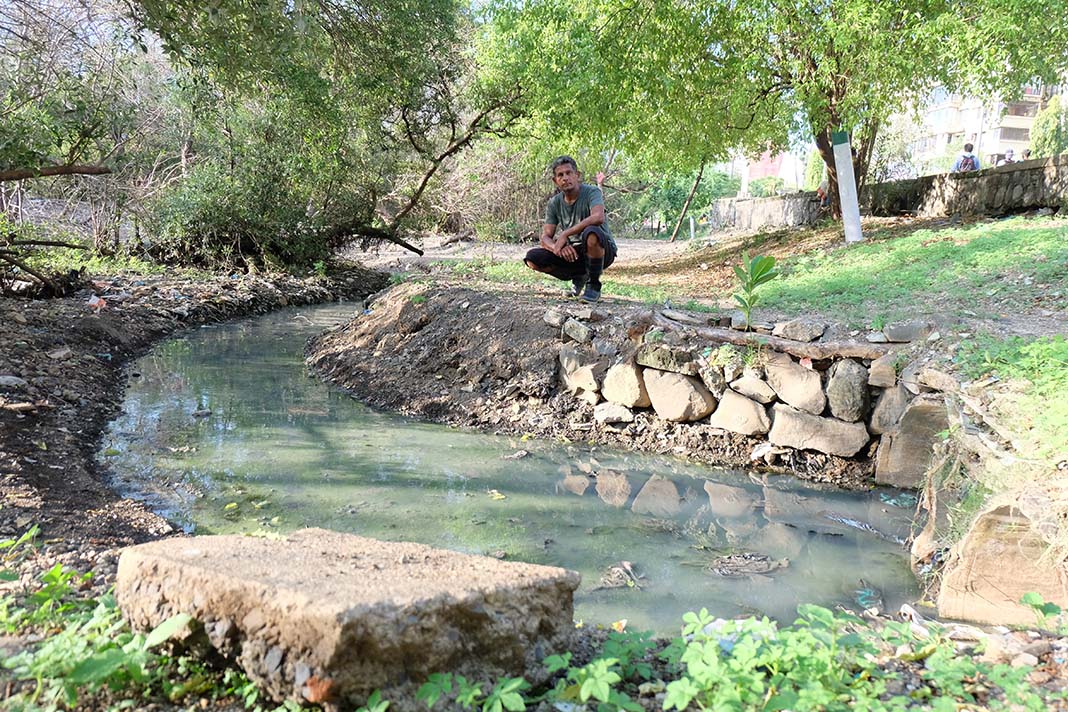Five years ago, when Rehan Merchant, a web designer by profession, began his work on the mangroves at Carter Road, people passing by or jogging on the promenade were sceptical about what he was doing. A man with a vision and determined to prove his point, nothing hindered Rehan’s effort and he continued to work with vigour. Now, the results lie in front of everyone, his persistence has paid off and through it, the mangroves are slowly turning over a new leaf.
Mangroves consist of halophytes, which are plants and trees that are highly salt-tolerant and can grow in an acidic environment with high salt content. Found along the Mumbai coastline, Carter Road is home to these mangroves. Mangroves consume a large amount of carbon dioxide from the atmosphere, thus, helping to maintain the climate and reduce pollution levels. There are three types of mangroves: red mangroves, black mangroves & white mangroves, named after the colour of their wood; all of which are found at Carter Road. The soil in mangroves consists of clay, silt or particles of rocks, sand and tiny particles of shells. They’re home to crabs, birds, bats, oysters, shells, sea vegetables and various types of algae and environmental bacteria and organisms.
If you happen to walk on the promenade at Carter Road & notice a man with a handcart, near the mangroves, you’ve come across Rehan Merchant. He has put up a few signs, as a brief note to the public, about what he’s doing and how it’s worked.
You might notice a lot of plastic bags or garbage and assume that waste was the problem. The truth is, Rehan never had a problem with the garbage & it was the least of his concerns. The actual problem was the sewage that was accumulating in an area of the mangroves & spreading through them. The smell used to be pathetic and the mangroves were filthy. As he explains, “Stagnant sewage water is very bad for the mangroves, however, if sewage water is flowing through; it doesn’t affect them. Mangroves, in a way, act as sewage treatment. The plants make sure that the sewage water volume is within its limits.”

The mangroves stretch into the sea: 350 metres from the Titan monument, 80 metres from the cabin in the middle and 380 metres at the end near Ganpati point. Rubble from the base of the Titan monument and tonnes of rubble from the walls of the promenade stretching from Otter’s Club to the monument, falling into the sea over decades led to the creation of an artificial shoreline, over the years. The artificial shoreline was further fortified, due to the accumulation of debris, sewage and the illegally built monument.
Rehan began working on the sewage issue by unclogging one of the sewage pipes & creating a trench and a canal with special architecture. Along with this, he also created a dam which restricted excess sea water from entering and allowed the sewage to flow out instead of accumulating in one area. This ensured that the trench did not fill up and allowed the sea water to enter at tide level and sewage to flush out. He cleaned up the debris and dug out a canal, starting from one of the sewage pipes, leading it away from the artificial shoreline. This made it easier for the tide to take away the sewage and clean up the area. He gradually cleaned the other side, where the second outlet of the sewage is.
A very positive aspect about Carter Road is the fact that most of it has been replaced by the mangroves, which is good news for us, the residents of Bandra! However, beyond the mangroves lies a beautiful, vast stretch of silt beach or a mud flat which is slowly evolving. This mud flat had about 50,000 to 60,000 stones at every ten foot interval, which over the past years has been removed by Rehan and in turn, used by him to re-create the fishing pond walls. Fishing pond walls should be marked as heritage, as he says, these walls were created by a generation of East Indian fishermen who came to stay in Sherly village many years ago. Another misleading concept, Rehan says, is that the mangrove will protect us from a huge wave or a strong tide; that is not true. Fishing pond walls are the barriers that will protect us, as they hold the tide back. The entire force of the tide is restricted from hitting the shore and damaging the walls. When the tide recedes, whatever silt it brings in, cannot flow out. This is ideally what gave rise to the mangroves. If there were no fishing pond walls, there would be no silt accumulation.
Rehan found an opportunity, whereby, due to the fishing pond walls; the silt that is brought in from the Mithi river & Juhu creek along with some sand from Juhu beach dragged in by the low tide, is held back by the fishing pond walls. He has understood the method of silt entering and accumulating, thus, helping reduce erosion & depletion of the mud flat.
Over the past 5 years, Rehan has moved and shuffled about 60,000 to 70,000 rocks, allowing more silt and sand to enter. Now, after all these years of work, it has become exponential; where larger quantities of silt enter and accumulate with each passing year, allowing the mangroves to flourish.
Rehan has one worker, who he funds through the support of the public. His efforts haven’t gone unnoticed and people now donate money and appreciate what he’s doing. He pays the worker six hundred rupees for six hours of work, a day. Rehan’s vision remains firm and his work will soon yield positive results such as removal of stagnant sewage water in all parts of the mangrove, removal of plastic and garbage inside the mangrove, beautification of silt beach or mud flat, creation of fishing ponds and a nursery to plant saplings and other plants.
Named ‘Prakritik Samadhan’, which translates to ‘Natural Solution’, his cause will benefit the generations to come; allowing them access to a more flourished and beautiful environment. He has started taking people for a tour through the mangrove to raise funds for the clearance of debris and to fund his worker. Do not miss out on this tour, for it is a wonderful experience and a definite must-try!





















